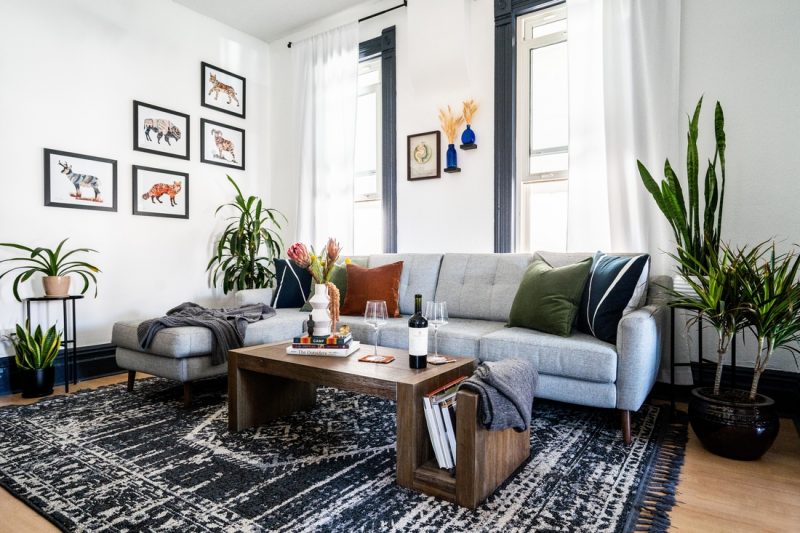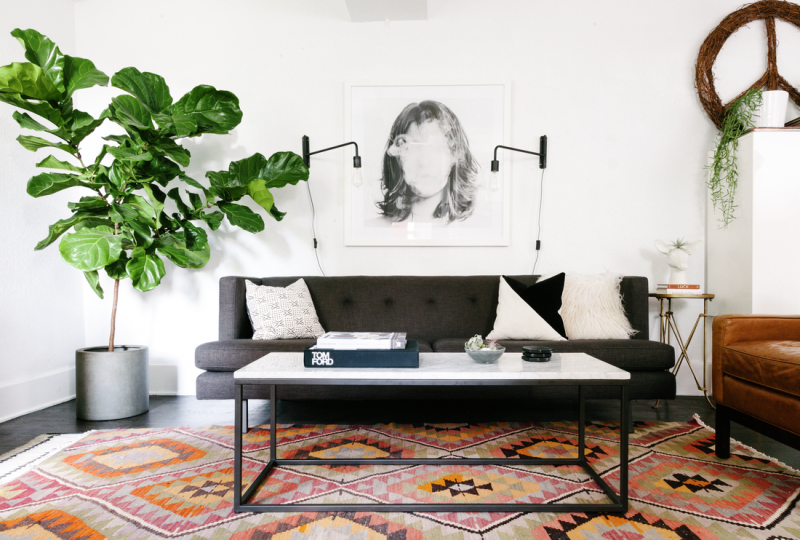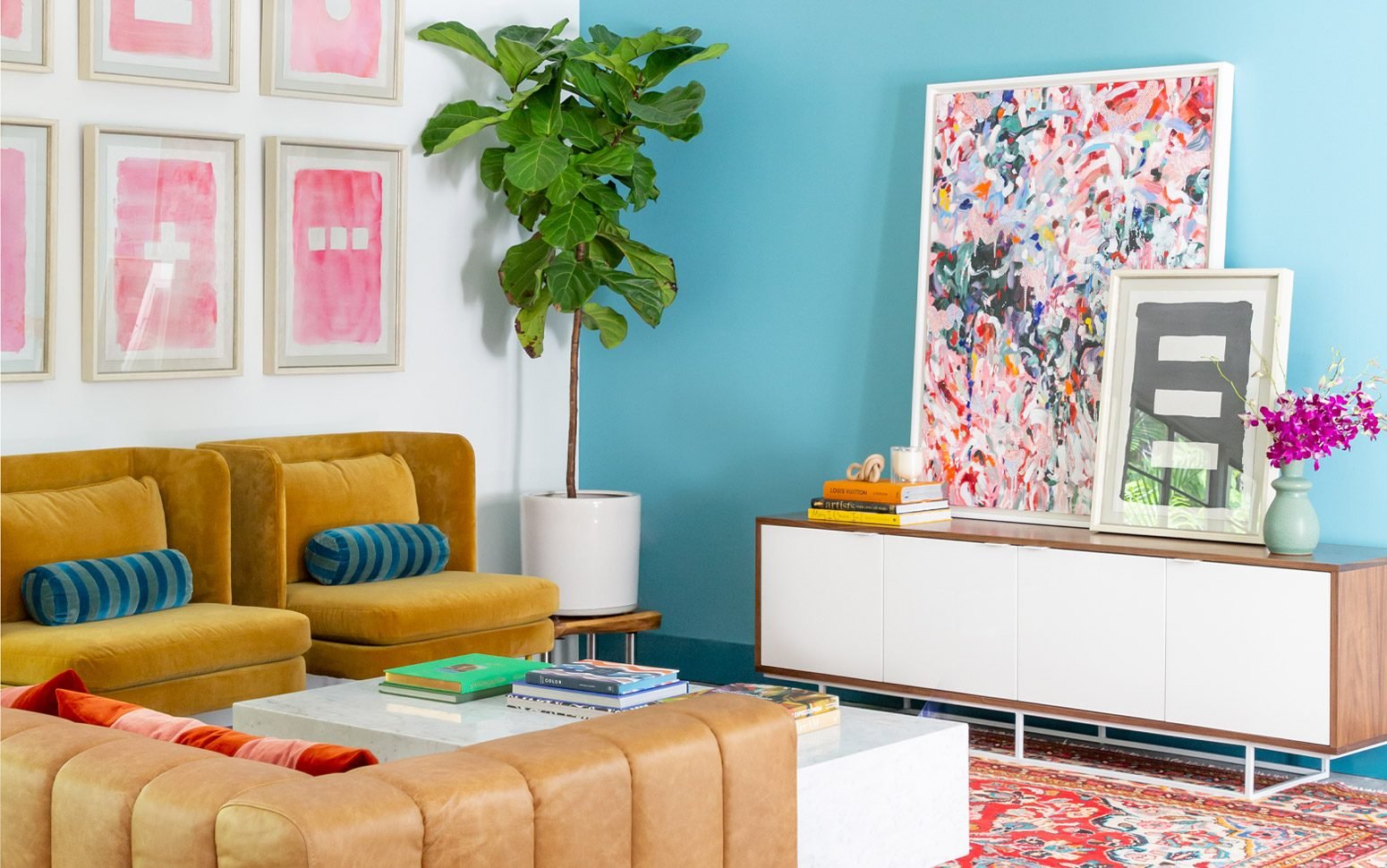Here at Havenly, we’ve never really left the houseplant bandwagon. While varieties and styles of plants cycle in and out of favor, there’s always room for a botanical moment. We fully endorse the escalation of “trend” to “craze” that the houseplant phenomenon has become, and with more time spent at home over the past year, there’s no time like the present to start (or grow!) your leafy aspirations.
That said, we’ve also watched in fear and resignation as our new friends wilt and… well, fail to recover… in a matter of weeks. As much as we adore a jungle vibe, we know that minimizing wasted dollars and disappointment is key (spoiler: we’re down with faux).
Keep reading for our take on how to incorporate houseplants into your home, tips for keeping your green friends growing, and Havenly-approved online sources for plants and accessories to elevate your greenery game.
Picking Your Spot
To get that indoor green game started, we recommend choosing one or two focus areas. While we’re always up for a challenge, think “easy win” on this one and head to your pad’s brightest area — a sill, bay window, or even sunny entry room perch. Use a smartphone compass (or the real thing…we see you, Eagle Scout) to determine the direction of the sun, keeping in mind that southern light will provide the broadest plant palette and northern light will provide mainly indirect light throughout the day. Light from the east or west will provide concentrated, direct light either early or late in the day, with indirect light otherwise (flip and reverse for our southern hemisphere friends!). If you have your pick of sun slants, go with southern; if not, no worries — there’s a plant type for most every nook, whether sun-bathed or shaded.
Lighting? Check. Now, before heading to your favorite nursery, break out your measuring tape and take some preliminary measurements. Are you looking for a grouping of foliage that takes up serious space, or a single plant that keeps its post in a smaller footprint? What’s the ideal diameter for your plant pot? Note that you’ll want to choose a plant that fits loosely in your chosen vessel, with some room to grow. Finally, what’s your commitment level — are you more constant primping and pruning, or set-it-and-forget-it? No judgment here! Plenty of plants actually do better with a more hands-off approach.

A Few Favorite Options to Grow On
Our design team loves the below options, whether to provide a styling moment alone or round out a well-considered space with texture and mood (we’ve also got recs for rooms across the sun exposure spectrum).
Sometimes, trendy and classic overlap in the best way, like in the case of an across-the-board favorite here at Havenly, the monstera deliciosa. Boasting a vibrant green coloring with instantly recognizable and endlessly ‘grammable Swiss cheese-like leaf holes, monstera is a go-to for sunny entryways and bright bedroom window sills alike. Monstera ticks all the right boxes: great volume and shape for the pot size, tolerant of moderate to bright indirect light, fast-growing, and amenable to dry soil in between thorough waterings. We recommend letting this one fly solo without additional plant groupings given its volume and size.
Another surefire addition for many spaces is the Never Never Plant (Cteananthe lubbersiana for you budding botanists out there). With hard-to-believe-it’s-natural variegated foliage that trades off between deep kelly green and day-glo lime, this evergreen perennial from Brazil really spreads and shines in bright, indirect light but will do fine with a bright interior placement, adding dimension and texture beside a couch or credenza. Try a deep, moss green planter in a natural texture for a tonal look that’s both cheerful and sophisticated.
If you’ve grown your skills with smaller potted plants and are ready to take a crack at a larger selection, we’ve fallen for the gorgeous Audrey Ficus (Ficus benghalensis). A close cousin of the ubiquitous Fiddle Leaf Fig, we think Audrey is a bit more forgiving option, with a higher tolerance for being relocated within the home (in our experience, fiddles don’t love to be moved!). Plus, that medium, dusty green shade straddles classic and fresh, playing well with many different styles. We’ve pinned and re-pinned Audreys in cream or taupe planter pots, making for a serene and inviting palette. While an investment, we think a larger, more established plant can completely make a room and actually be a bit more forgiving of occasional missed waterings, as long as you really give a good soak when the top few inches of the soil are dry to the touch.
Speaking of statements, the European olive tree (Olea europaea) is having a moment right now, and we’re here for it—the sculptural, delicate foliage and quick growth make a starter olive tree an unexpected, architectural table centerpiece (pair with a black stoneware planter for next-level luxe!), while a larger olive tree will thrive next to a patio door. Full disclosure and fair warning: this plant requires a lot of water and sun to properly grow, so save for a sun-filled placement near a succulent grouping.
If your apartment isn’t drenched in sun from dawn to dusk, don’t despair — the trick is choosing plants that make the most of moderate light. We recommend starting out strong with a perennial favorite, the pothos (Epipremnum aureum). Available in a variety of striations and leaf designs, this climbing vine from the South Pacific tolerates a wide range of soil, light and humidity conditions. One creative way we’ve used common pothos in our designs is by perching a larger planter atop upper kitchen cabinets, with vines draping down into a picture window over the sink for a verdant view while washing up.
While we won’t argue that the Zanzibar Gem, or “ZZ” plant (Zamioculcas) is at this point the Meryl Streep of the low-light plant world (i.e. proven in every situation and beloved by all), we’d recommend confirming comfort with the plants toxicity, particularly if you have pets and little ones. For low-light alternatives that still pack a high-design punch, we’ve been enjoying an asparagus fern, or angel vine tucked into a shady corner of a bathroom or kitchen to add texture and color.
Finally, don’t forget faux! There’s no shame in incorporating…ahem…evergreen…selections into your space, particularly for your shadiest areas where vision and viability don’t necessarily align. After all, it’s better to enjoy the shape and pot of a faux plant than to fret away budget and sanity watching its organic counterpart struggle and shrivel. Retailers such as Crate & Barrel, West Elm and Pottery Barn have all thoroughly modernized the faux plant for the modern enthusiast, putting yesteryear’s sad silk numbers to shame. We might advise using a bark or stone topsoil, choosing a unique pot or vessel, and keeping watch for dust accumulation to maintain an authentic look and feel for faux pieces.

Rounding It Out: Accessories, and Some Starting Points
There’s never been a better time to be an indoor plant enthusiast, whether dipping a toe or diving deep into all things houseplant. We constantly trawl Gardenista and The Spruce for inspiration, tips, and tricks, and the latest trends within the ever-expanding houseplant community. Bloomscape has excellent plant care guides and clear troubleshooting help for the inevitable droops and drops. And while we always love supporting local nurseries and bespoke guidance that a neighborhood gardening center can provide, we’ve had great experiences with select online purveyors, too, including our friends at Greenery Unlimited and The Sill.
For how-to guides and inspiration that double as coffee table tomes (or styling accessories for your new finds), we return again and again Sophie Lee’s Living with Plants: A Guide to Indoor Gardening and Hilton Carter’s Wild at Home for a refresh or a reminder of how houseplants can both elevate and ground most any home aesthetic.
We get it. With so many types and kinds of plants to choose from, knowing where to start incorporating greenery into your home’s design can be a stumbling block. That said, we think that the gap between online inspiration and real-life indoor oasis isn’t as wide as many make it out to be. While keeping houseplants bright and budding does take some maintenance and advanced planning, we think there’s just too many great styles and varied selections available not to test your thumb as we round into spring.

To keep the conversation going on how to green up your space with any style and budget, drop us a line for a personalized consultation.

